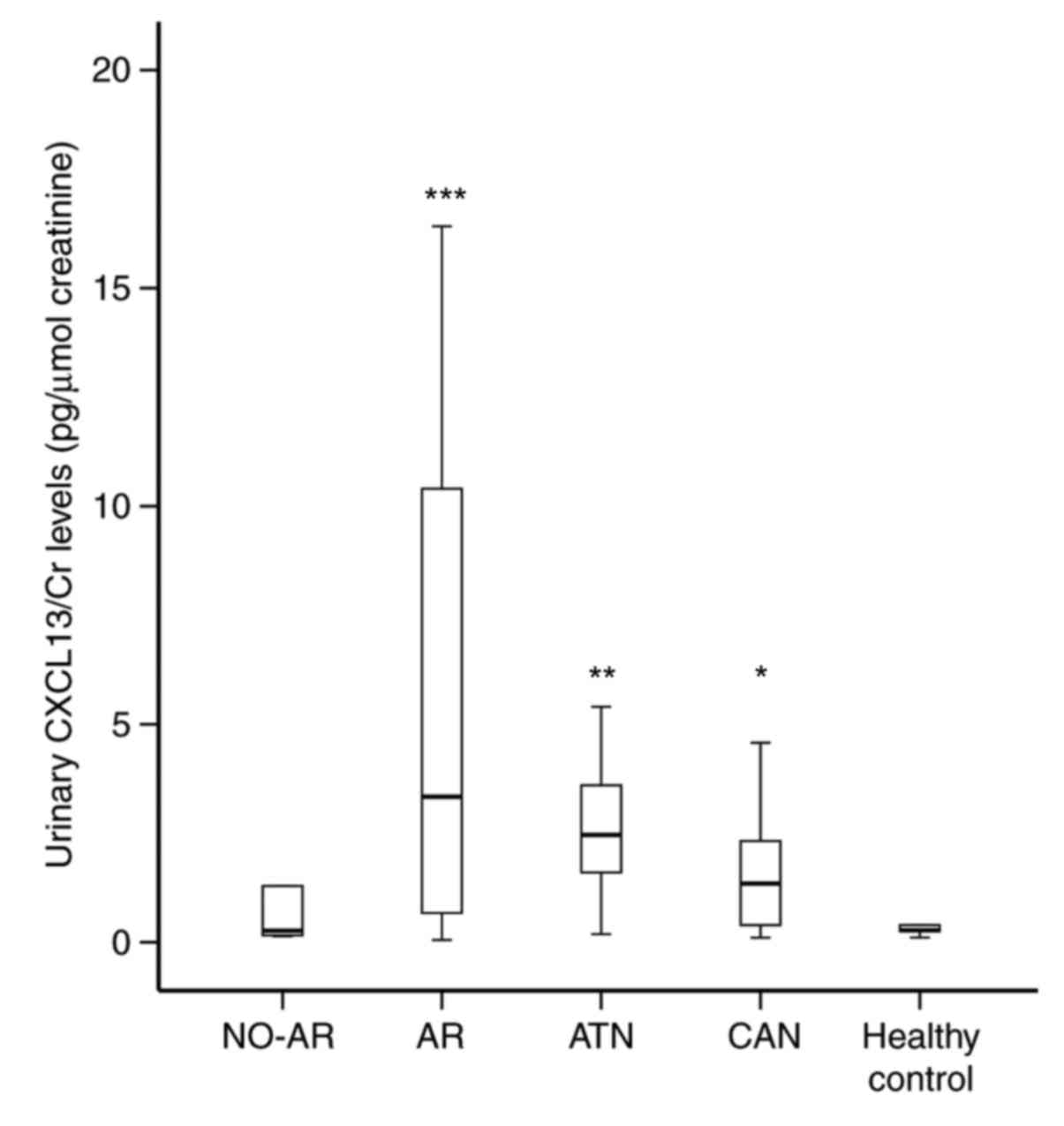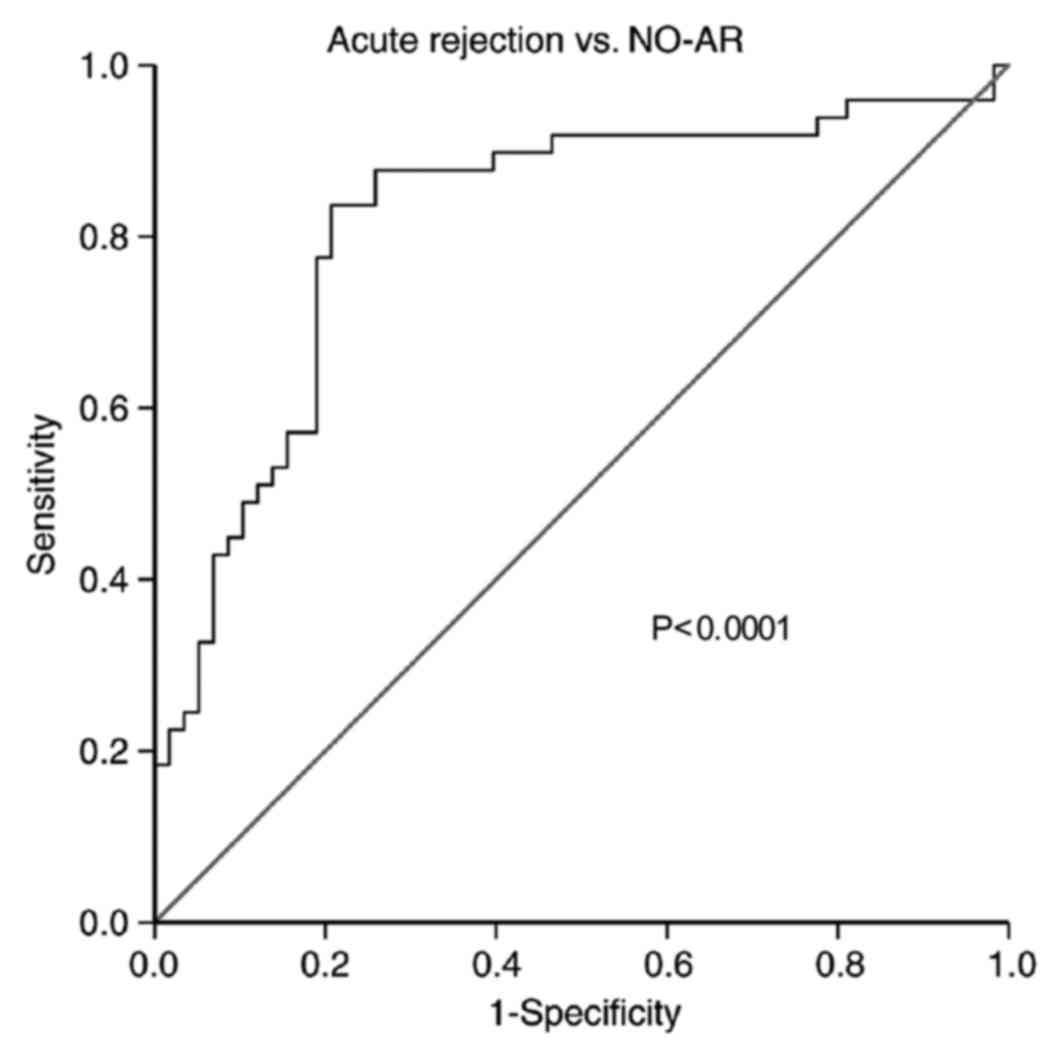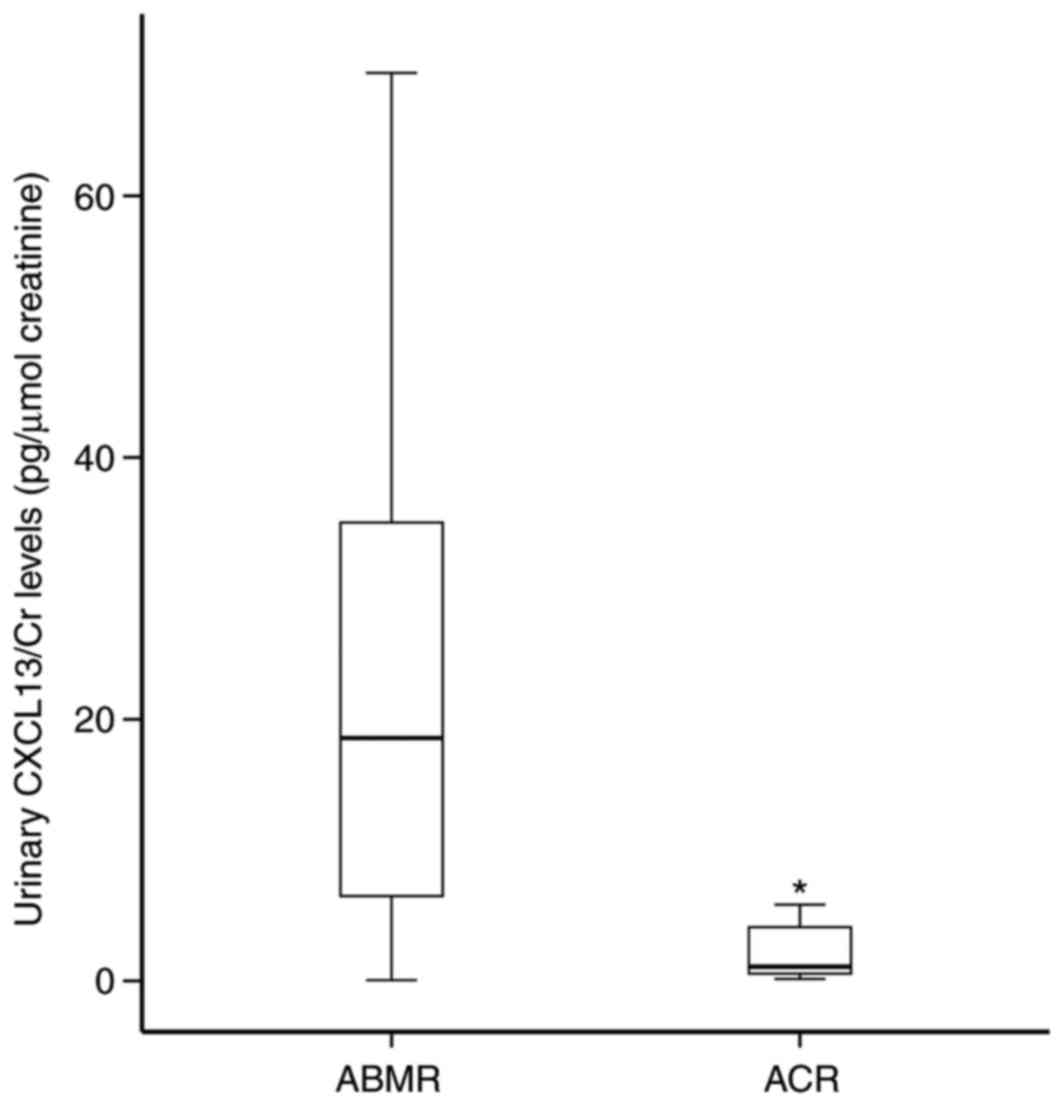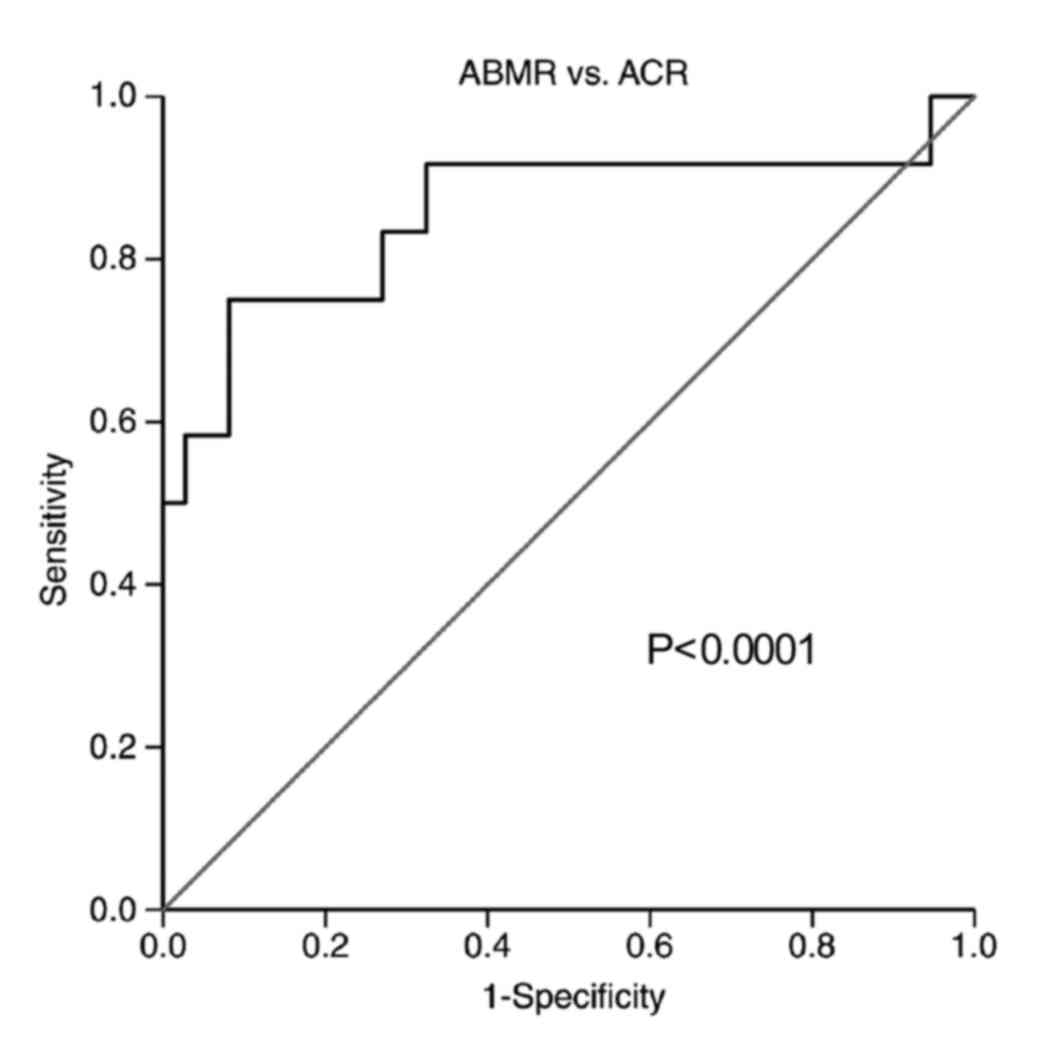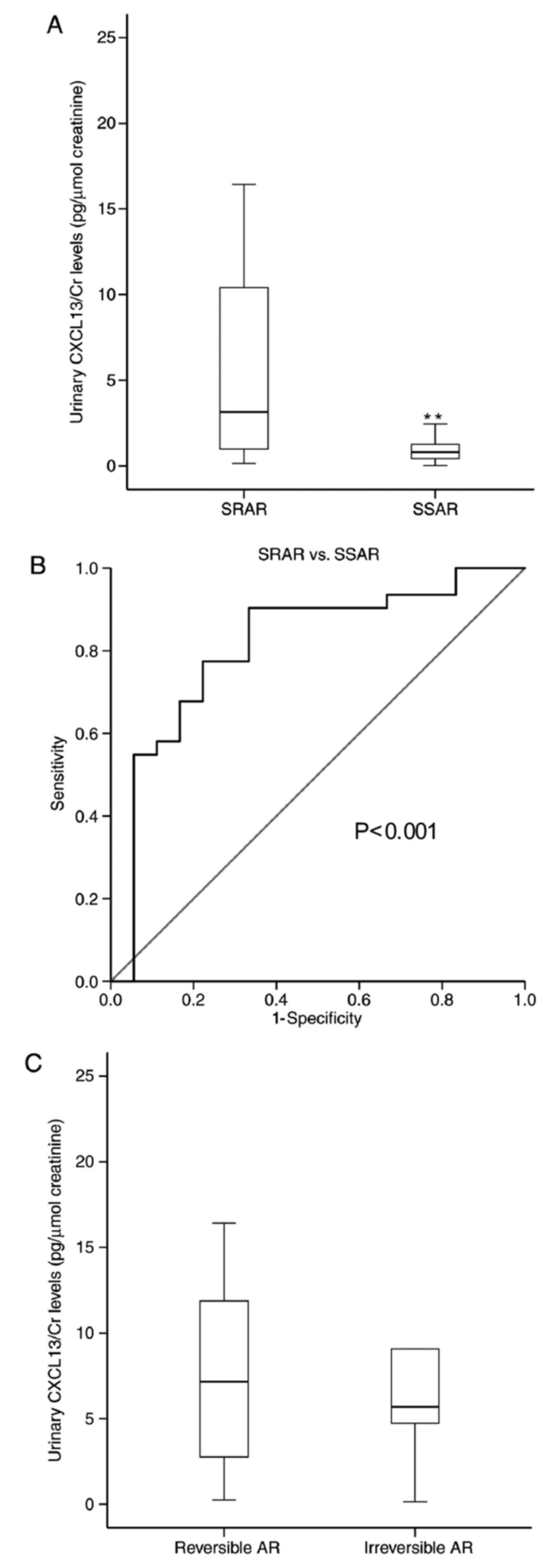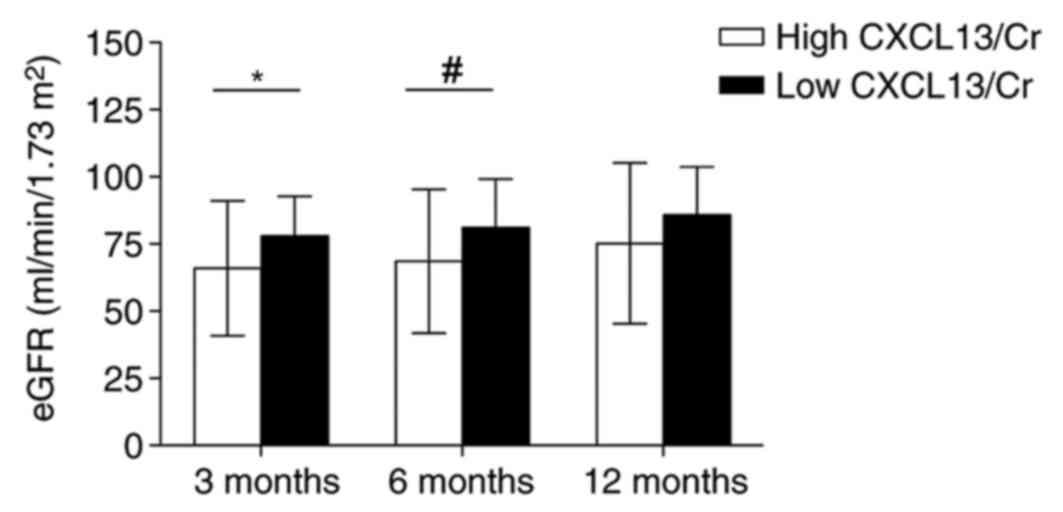|
1
|
Garcia GG, Harden P and Chapman J: World
Kidney Day Steering Committee 2012: The global role of kidney
transplantation. Lancet. 379:e36–e38. 2012. View Article : Google Scholar : PubMed/NCBI
|
|
2
|
Ezzat M, El-Gammasy T, Shaheen K and Shokr
E: Elevated production of serum B-cell-attracting chemokine-1
(BCA-1/CXCL13) is correlated with childhood-onset lupus disease
activity, severity, and renal involvement. Lupus. 20:845–854. 2011.
View Article : Google Scholar : PubMed/NCBI
|
|
3
|
Hu H, Aizenstein BD, Puchalski A, Burmania
JA, Hamawy MM and Knechtle SJ: Elevation of CXCR3-binding
chemokines in urine indicates acute renal-allograft dysfunction. Am
J Transplant. 4:432–437. 2004. View Article : Google Scholar : PubMed/NCBI
|
|
4
|
Velaga S, Herbrand H, Friedrichsen M,
Jiong T, Dorsch M, Hoffmann MW, Förster R and Pabst O: Chemokine
receptor CXCR5 supports solitary intestinal lymphoid tissue
formation, B cell homing, and induction of intestinal IgA
responses. J Immunol. 182:2610–2619. 2009. View Article : Google Scholar : PubMed/NCBI
|
|
5
|
Förster R, Mattis AE, Kremmer E, Wolf E,
Brem G and Lipp M: A putative chemokine receptor, BLR1, directs B
cell migration to defined lymphoid organs and specific anatomic
compartments of the spleen. Cell. 87:1037–1047. 1996. View Article : Google Scholar : PubMed/NCBI
|
|
6
|
Förster R, Emrich T, Kremmer E and Lipp M:
Expression of the G-protein-coupled receptor BLR1 defines mature,
recirculating B cells and a subset of T-helper memory cells. Blood.
84:830–840. 1994.PubMed/NCBI
|
|
7
|
Gunn MD, Ngo VN, Ansel KM, Ekland EH,
Cyster JG and Williams LT: A B-cell-homing chemokine made in
lymphoid follicles activates Burkitt's lymphoma receptor-1. Nature.
391:799–803. 1998. View
Article : Google Scholar : PubMed/NCBI
|
|
8
|
Smith JR, Braziel RM, Paoletti S, Lipp M,
Uguccioni M and Rosenbaum JT: Expression of B-cell-attracting
chemokine 1 (CXCL13) by malignant lymphocytes and vascular
endothelium in primary central nervous system lymphoma. Blood.
101:815–821. 2003. View Article : Google Scholar : PubMed/NCBI
|
|
9
|
Amft N, Curnow SJ, Scheel-Toellner D,
Devadas A, Oates J, Crocker J, Hamburger J, Ainsworth J, Mathews J,
Salmon M, et al: Ectopic expression of the B cell-attracting
chemokine BCA-1 (CXCL13) on endothelial cells and within lymphoid
follicles contributes to the establishment of germinal center-like
structures in Sjogren's syndrome. Arthritis Rheum. 44:2633–2641.
2001. View Article : Google Scholar : PubMed/NCBI
|
|
10
|
Shi K, Hayashida K, Kaneko M, Hashimoto J,
Tomita T, Lipsky PE, Yoshikawa H and Ochi T: Lymphoid chemokine B
cell-attracting chemokine-1 (CXCL13) is expressed in germinal
center of ectopic lymphoid follicles within the synovium of chronic
arthritis patients. J Immunol. 166:650–655. 2001. View Article : Google Scholar : PubMed/NCBI
|
|
11
|
Mazzucchelli L, Blaser A, Kappeler A,
Schärli P, Laissue JA, Baggiolini M and Uguccioni M: BCA-1 is
highly expressed in Helicobacter pylori-induced mucosa-associated
lymphoid tissue and gastric lymphoma. J Clin Invest. 104:R49–R54.
1999. View
Article : Google Scholar : PubMed/NCBI
|
|
12
|
Steinmetz OM, Stahl RA and Panzer U:
Chemokines and B cells in renal inflammation and allograft
rejection. Front Biosci (Schol Ed). 1:13–22. 2009. View Article : Google Scholar : PubMed/NCBI
|
|
13
|
Steinmetz OM, Panzer U, Kneissler U,
Harendza S, Lipp M, Helmchen U and Stahl RA: BCA-1/CXCL13
expression is associated with CXCR5-positive B-cell cluster
formation in acute renal transplant rejection. Kidney Int.
67:1616–1621. 2005. View Article : Google Scholar : PubMed/NCBI
|
|
14
|
Mao Y, Wang M, Zhou Q, Jin J, Wang Y, Peng
W, Wu J, Shou Z and Chen J: CXCL10 and CXCL13 Expression were
highly up-regulated in peripheral blood mononuclear cells in acute
rejection and poor response to anti-rejection therapy. J Clin
Immunol. 31:414–418. 2011. View Article : Google Scholar : PubMed/NCBI
|
|
15
|
Chen D, Peng W, Jiang H, Yang H, Wu J,
Wang H and Chen J: Noninvasive detection of acute renal allograft
rejection by measurement of soluble Tim-3 in urine. Mol Med Rep.
16:915–921. 2017. View Article : Google Scholar : PubMed/NCBI
|
|
16
|
Racusen LC, Solez K, Colvin RB, Bonsib SM,
Castro MC, Cavallo T, Croker BP, Demetris AJ, Drachenberg CB, Fogo
AB, et al: The Banff 97 working classification of renal allograft
pathology. Kidney Int. 55:713–723. 1999. View Article : Google Scholar : PubMed/NCBI
|
|
17
|
Peng W, Chen J, Jiang Y, Shou Z, Chen Y
and Wang H: Acute renal allograft rejection is associated with
increased levels of vascular endothelial growth factor in the
urine. Nephrology (Carlton, Vic.). 13:73–79. 2008.PubMed/NCBI
|
|
18
|
Wu JY, Chen JH, Wang YM, He Q and Wu DB:
Improved clinical outcomes in Chinese renal allograft recipients
receiving lower dose immunosuppressants. Transplantation.
78:713–718. 2004. View Article : Google Scholar : PubMed/NCBI
|
|
19
|
Racusen LC, Halloran PF and Solez K: Banff
2003 meeting report: New diagnostic insights and standards. Am J
Transplant. 4:1562–1566. 2004. View Article : Google Scholar : PubMed/NCBI
|
|
20
|
Matz M, Beyer J, Wunsch D, Mashreghi MF,
Seiler M, Pratschke J, Babel N, Volk HD, Reinke P and Kotsch K:
Early post-transplant urinary IP-10 expression after kidney
transplantation is predictive of short- and long-term graft
function. Kidney Int. 69:1683–1690. 2006. View Article : Google Scholar : PubMed/NCBI
|
|
21
|
Hu H, Kwun J, Aizenstein BD and Knechtle
SJ: Noninvasive detection of acute and chronic injuries in human
renal transplant by elevation of multiple cytokines/chemokines in
urine. Transplantation. 87:1814–1820. 2009. View Article : Google Scholar : PubMed/NCBI
|
|
22
|
Hricik DE, Nickerson P, Formica RN, Poggio
ED, Rush D, Newell KA, Goebel J, Gibson IW, Fairchild RL, Riggs M,
et al: Multicenter validation of urinary CXCL9 as a
risk-stratifying biomarker for kidney transplant injury. Am J
Transplant. 13:2634–2644. 2013. View Article : Google Scholar : PubMed/NCBI
|
|
23
|
Ho J, Rush DN, Krokhin O, et al: Elevated
urinary matrix metalloproteinase-7 detects underlying renal
allograft inflammation and injury. Transplantation. 100:648–654.
2016. View Article : Google Scholar : PubMed/NCBI
|
|
24
|
Rabant M, Amrouche L, Lebreton X, Aulagnon
F, Benon A, Sauvaget V, Bonifay R, Morin L, Scemla A, Delville M,
et al: Urinary C-X-C motif chemokine 10 independently improves the
noninvasive diagnosis of antibody-mediated kidney allograft
rejection. J Am Soc Nephrol. 26:2840–2851. 2015. View Article : Google Scholar : PubMed/NCBI
|
|
25
|
Jenh CH, Cox MA, Hipkin W, Lu T,
Pugliese-Sivo C, Gonsiorek W, Chou CC, Narula SK and Zavodny PJ:
Human B cell-attracting chemokine 1 (BCA-1; CXCL13) is an agonist
for the human CXCR3 receptor. Cytokine. 15:113–121. 2001.
View Article : Google Scholar : PubMed/NCBI
|
|
26
|
Kielczewski JL, Horai R, Jittayasothorn Y,
Chan CC and Caspi RR: Tertiary lymphoid tissue forms in retinas of
mice with spontaneous autoimmune uveitis and has consequences on
visual function. J Immunol. 196:1013–1025. 2016. View Article : Google Scholar : PubMed/NCBI
|
|
27
|
Crotty S: Follicular helper CD4 T cells
(TFH). Ann Rev Immunol. 29:621–663. 2011. View Article : Google Scholar
|
|
28
|
Kim CH, Lim HW, Kim JR, Rott L, Hillsamer
P and Butcher EC: Unique gene expression program of human germinal
center T helper cells. Blood. 104:1952–1960. 2004. View Article : Google Scholar : PubMed/NCBI
|
|
29
|
Rasheed AU, Rahn HP, Sallusto F, Lipp M
and Muller G: Follicular B helper T cell activity is confined to
CXCR5(hi)ICOS(hi) CD4 T cells and is independent of CD57
expression. Eur J Immunol. 36:1892–1903. 2006. View Article : Google Scholar : PubMed/NCBI
|
|
30
|
Haas M, Sis B, Racusen LC, Solez K, Glotz
D, Colvin RB, Castro MC, David DS, David-Neto E, Bagnasco SM, et
al: Banff 2013 meeting report: Inclusion of c4d-negative
antibody-mediated rejection and antibody-associated arterial
lesions. Am J Transpl. 14:272–283. 2014. View Article : Google Scholar
|















